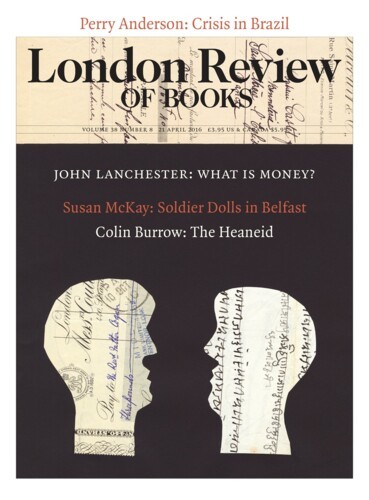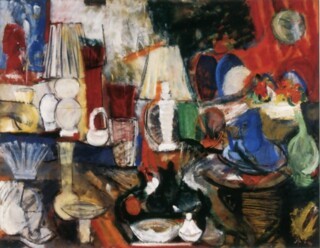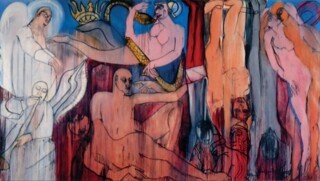On a spring day in New York City in 1960, Grace Hartigan, then 38 years old, took the train uptown to visit Winston Price, a young scientist from Baltimore, and a new collector of her work. To anyone who saw her on the subway, she wouldn’t have looked like a painter; ‘when I go out,’ she said, ‘I’m all woman.’ Her work had just begun to sell, and to celebrate she had bought furs, jewellery and handbags. The woman who stepped onto Fifth Avenue looked like she belonged there.
Hartigan knew success early. In 1953, during her third solo exhibition at the Tibor de Nagy Gallery, the director of the Museum of Modern Art, Alfred J. Barr, had taken one of her paintings, The Persian Jacket, off the wall of the gallery and back with him to MoMA. (Her close friend Frank O’Hara, working at the museum’s front desk, was there to see Grace’s official entry into the museum; the painting fitted into the cab, but not through the revolving doors, and had to be taken in through a side entrance.) She was the first of her painter friends – Alfred Leslie, Mike Goldberg, Larry Rivers and Jane Freilicher – to be taken seriously by the academy. The following year, MoMA purchased River Bathers for $1000. The accolades piled up. In 1956, Hartigan was the only woman artist to be selected for MoMA’s exhibition Twelve Americans. She was the only woman (and the youngest artist) to be included in the influential New American Painting exhibition, which toured Europe during 1958-59. Nelson Rockefeller bought a painting, as did the playwright William Inge. Life magazine called her ‘the most celebrated of the young American women painters’.
That spring day in 1960, Hartigan knew that Price’s star was also on the rise; a very young associate professor of epidemiology at the Johns Hopkins University School of Hygiene and Public Health, he had been profiled by Life magazine on account of his research into vaccines for Rocky Mountain spotted fever and other rickettsial infections. He had recently signed a contract with the Department of Defense to study typhus in the armed forces. And he was an enthusiastic collector of Abstract Expressionism, a friend of Philip Guston, and a correspondent of Robert Motherwell. He had already bought Hartigan’s August Harvest, which she had painted in Long Island the previous summer. He was interesting, and interested. He knew Hartigan’s world, but was not of it. He needed as much space and time to work as she did. And he was just as ambitious as she was.
What Hartigan didn’t know was that, even as a child, Price was known for his tall tales, and that, as a scientist, he had probably fabricated the results of a study that seemed to promise a cure for influenza. She couldn’t know that, five years after they met, he would begin to inject himself with a series of trial vaccines for encephalitis, and start to experience symptoms of the disease, including ‘impaired judgment, inappropriate responses, memory loss, anxiety and personality changes’. His deceptions would increase in scale and number. He would begin to lie about the art he hadn’t bought and to hide the art he had. He would promise to lend money he didn’t have. He would continue to fabricate research results and insist that he and Hartigan move so he could take up a job he hadn’t been offered. He would tell friends that the Corcoran Gallery and Whitney Museum were going to show Hartigan’s work when they weren’t. It was inevitable he would be caught out, and yet he persisted. It was this compulsiveness more than anything that indicated something was wrong. But all this was to come. In 1960, Price ordered enough flowers to fill his hotel suite. Hartigan arrived, and stayed for three days.
In biographies deeds tend to outstrip loves, so it’s particularly interesting that Cathy Curtis begins her Life of Hartigan, Restless Ambition, on the day she met Price. We meet Hartigan on the way up, but also, unwittingly, on her way down. If Hartigan hadn’t met Price, she wouldn’t have moved to Baltimore, which she later called ‘the disaster of my life’.
Hartigan had been in love before; Price became her fourth husband, and she had also had a number of long-term boyfriends, including Alfred Leslie and the photographer Walter Silver. (When she left Price’s suite at the Sherry Netherland Hotel it was to tell Robert Keene, her third husband, she wanted a divorce.) Throughout the book, Curtis is quietly attentive to the ways in which Hartigan tried to balance intimacy, artistic freedom and economic stability. She tried hard to avoid the sort of relationship where the woman has to give up her art to keep her artist husband financially afloat. Curtis pays attention to the economics of love. Here is her comparison of Hartigan with Helen Frankenthaler: ‘Divorced from Motherwell in 1971, Helen would marry an investment banker in 1994 and spend her last years in a wealthy enclave in Connecticut.’
Hartigan’s willpower was a thing of terrible beauty. It got her to New York, no small feat for someone who grew up in suburban New Jersey, married at 19, gave birth at 20, and found herself, at 21, a single mother living in Newark, working as a draughtsman during the week and painting watercolours of Dutch shoes with trailing ivy at the weekends. She discovered modern art when a colleague lent her a book. A boyfriend, Ike Muse, introduced her to the downtown painting scene, and she moved to Manhattan with him, but just as soon decided that if she wanted to paint, she couldn’t do it in a man’s shadow, or as a mother. At 26, she dumped Muse, left her son with her in-laws, and went to live, alone, in a cold-water walk-up in midtown. It was a gutsy, if chilly move. Hartigan wouldn’t see her son again for more than thirty years.
Curtis does not say it outright – at least, not immediately – but Hartigan was known as a socially difficult person, quick to take and to give offence. She had a reputation for being an aggressive drunk, and a habit of isolating herself. She often felt like the only female painter in the room, even when she wasn’t. She consistently envied her colleagues’ and friends’ successes. After visiting her friend Joan Mitchell’s exhibition in 1952, Hartigan wrote in her diary that it was ‘a fantastic display of youthful talent and virtuosity, without the real thing’. After spending the day with another friend, Jane Freilicher (they gossiped, shopped and looked round each other’s studios), she wrote that Freilicher’s paintings were ‘timid and almost sentimental’. Hartigan was witty, intelligent, driven and talented, and loved to be adored, but she wasn’t kind.
She was one of O’Hara’s muses, and he dedicated several poems to her, including ‘For Grace, after a Party’, ‘Christmas Card to Grace Hartigan’ and ‘Portrait of Grace’. Receiving this last poem, Hartigan wrote that it ‘makes me feel as though I exist now. I get so confused about myself, as though only the paintings are real. The poem makes me have an existence.’ The gift of attention could be profoundly sustaining – and Hartigan was generous in return. She designed the cover for a collection of O’Hara’s poems (written to accompany an exhibition of hers), and embarked on an ambitious series of 12 paintings based on the prose poems ‘Twelve Pastorals’ in which she incorporated many of O’Hara’s lines. She is the Grace mentioned on O’Hara’s gravestone, in a line from ‘In Memory of My Feelings’: ‘Grace to be born and live as variously as possible.’ And yet in 1960 or 1961 she wrote him a ‘Dear John’ letter, ending their friendship. Her therapist had told her that her attachment to him was stifling other intimacies. O’Hara was wounded; friendships waxed and waned, but declaring a split in this way felt violent.
O’Hara could be cruel too, especially when drunk. Many of Hartigan’s friends prided themselves on their wit and her own edge was welcome. The group of young painters and poets who coalesced around the Tibor de Nagy Gallery in the early 1950s – which, along with Hartigan, included Frankenthaler, Freilicher, Mitchell, Leslie, Rivers, O’Hara, Kenneth Koch, John Ashbery and James Schuyler – liked their conversation dry and shaded. But Hartigan could also be oppressively earnest. Immediately after describing the day she spent with Freilicher, Hartigan continued: ‘Her desire to “draw” well makes her timid & fearful. I have learned that “technique” must be approached with the same hand & courage, the same directness as “expression”. Of course I do have a great deal more competence than I had ever realised, and it seems to be growing all the time.’ A week before, she had had coffee with Leslie and discussed Expressionism. ‘I’m going to grapple with the monster,’ she wrote in her diary afterwards, ‘use it, drain it, eat it, and eventually I know I’ll throw it away.’ Her sense of a titanic struggle often landed heavily. Ashbery wrote that he and O’Hara ‘felt that art is already serious enough; there is no point in making it seem even more serious by taking it too seriously.’ Hartigan may not have entirely agreed.
In the early 1950s Hartigan dated Walter Silver, who ended up documenting much of the scene, photographing readings, exhibitions, magazine launches and parties. There are photos of Hartigan learning to silk-screen, bent over the tray in concentration, backlit by large loft-like windows; of her frowning in concentration at a life-drawing class, dancing in Central Park while holding a kite, throwing her head back in laughter in the Cedar Tavern, her neck the whitest thing in the dark room. Here she is sitting next to friends, smoking and drinking and talking.
Many of these young poets and artists had moved to New York in the late 1940s to learn from older downtown painters such as de Kooning, Pollock and Kline, who had worked for decades in isolation and penury. That was now changing. The term ‘New York School’, initially coined to describe a number of abstract painters and sculptors, widened to include younger artists and writers. John Bernard Myers, director of the Tibor de Nagy Gallery, began to refer to a ‘New York School of Poets’ (which happened to be those whose work his gallery had published). As the 1950s progressed, Hartigan’s coterie became well known and visible. In 1954, for her painting Masquerade, Hartigan put seven of her friends in fancy dress and had Silver photograph them as a group, staging their friendship for the public. (Freilicher was a bride, O’Hara a jester, and Ashbery wore short shorts and a white mask.)
When people choose to tell the story of the New York School (largely a story of its beginnings), their anecdotes often organise themselves around these visual reminders, which are, of course, highly subjective accounts of intimacy that often appear more objective simply because they describe a group. When she moved to Baltimore in 1960 Hartigan was on her own. This may help to explain why relatively little attention has been paid to her time there. In 1960, the snobbish consensus within the New York art world was that Baltimore was another country, despite being only a four-hour drive away. Although many other artists were leaving New York at the time, they went to Paris, or Long Island, well-established alternatives with like-minded communities. Even Vermont, Cape Cod and Maine felt closer; at least people summered there. After moving to Baltimore, Hartigan’s career never recovered.
The move seemed to exacerbate her stylistic restlessness. When Hartigan had used oil paint in the 1950s in New York her ideas about colour were articulated by the texture of the paint and her brushstrokes. You couldn’t speak of a white or red without noticing her application of it, and the emotion was in the effort; there is often the sense you are looking at the traces of a fight. In Baltimore, Hartigan started to experiment with washes of watercolour, and black outlines. The effect seemed effortless, even casual. The colours glow, more gas than solid. Lily Pond (1962) is a study in intense greens and blues, an expression of Hartigan’s pleasure in perceiving colour, shape and line. Her love of Matisse is obvious. But this approach to figure and colour was thought vieux jeu. Her show at the Martha Jackson Gallery in Manhattan in 1962 was sparsely attended; the first of a number of unsuccessful exhibitions. Hartigan began to doubt her lyricism, and later felt this work was too easy, too beautiful. In the 1970s, she began to ‘punish’ her canvases, scrubbing them with sandpaper and stepping on them. This restlessness produced works that seemed incoherent, both visually and emotionally.
In Baltimore, Hartigan missed the daily squabbles and gossip of New York, the unofficial studio visits and passionate, drunken, late-night conversations. These exchanges improved her work, but they were often difficult, and she probably underestimated their value. She couldn’t find artists or writers in Baltimore who wouldn’t simply defer to her opinion. For more than four decades, she was the chair of the Hoffberger School of Painting at the Maryland Institute College of Art, and directed the graduate painting programme. People found her intimidating and she became unused to disagreement. In her paintings, Hartigan lost the tautness that can come from a conversation between equals. Another way of putting it is to say she lost her instinct for the viewer; of what kind of understanding they might come to, and why. ‘With her persistent worries about going “soft”,’ Curtis writes, ‘Grace seems to have had trouble distinguishing the worthwhile and necessary difficulties involved in creating exceptional work with viewers’ enjoyment of it.’
In the 1970s Price’s health deteriorated and Hartigan began to drink more. In 1981 Price died, soon followed by Hartigan’s mother, and Hartigan stopped drinking, finding comfort in Alcoholics Anonymous’s emphasis on a higher power. She continued to paint, and enjoyed a resurgence of critical and public interest in her work, but her prices didn’t climb in the way that Frankenthaler or Mitchell’s did (they had also moved away from New York City around the time she did). She died in 2008.
Even in her early diaries, Hartigan was guarded, and vulnerability was often only expressed as self-pity. She told her therapist, near the end of her life, that she didn’t feel guilty about abandoning her son. She wrote to her granddaughter that, as women, they had nothing in common. Yet the vehemence with which she denied the pull of blood is the strongest indication of her passion for painting. Curtis’s biography captures the mute stubbornness involved in persisting with life, despite its many disappointments.
In the coming years, biographies of Ashbery and Schuyler will be published. Curtis is now at work on a biography of Elaine de Kooning. It seems quite possible that the cumulative effect of these works will be quietly to reshape a milieu we think we know. We have many stories about the New York School’s beginnings, and a few about its endings, but fewer still about what happened in the middle, those decades when you move through life preoccupied with the task to hand: what to paint, what to write, what to work on. And there is Hartigan, stomping along.
Send Letters To:
The Editor
London Review of Books,
28 Little Russell Street
London, WC1A 2HN
letters@lrb.co.uk
Please include name, address, and a telephone number.




